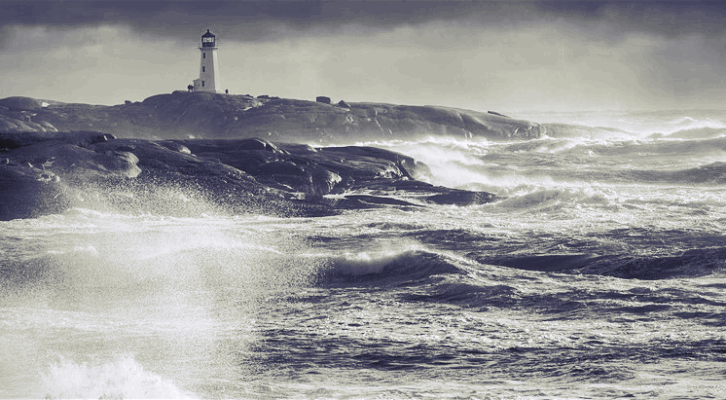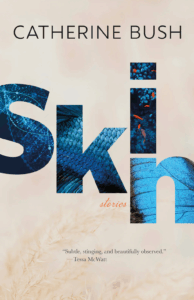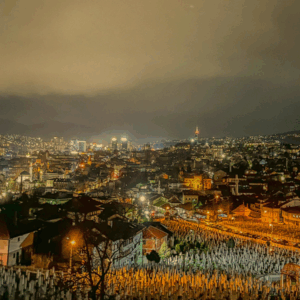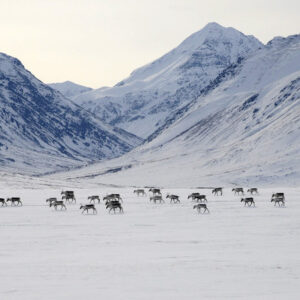
Writing the Wind: Capturing the Sensation of Life's Many Storms
"All storms are alike yet each speaks to us in its particularity."
I arrived in Halifax, Nova Scotia, in late September 2022, days after Hurricane Fiona blew through. The most intense Category Four hurricane ever recorded this far north, it had weakened to a post-tropical storm as it surged towards the Nova Scotia coast. Spinning northwest, the storm ripped across Cape Breton Island, the northerly section of the province. It churned over Prince Edward Island, tearing away the famous red sand beaches, before making for the southwesterly tip of Newfoundland. There, in the fishing village of Port aux Basques, wind and the largest storm surge ever recorded in the area swept houses and a woman out to sea.
In Halifax, broken trees still teetered on lawns, ripped-off tree limbs massed along the roadsides. My cab driver regaled me with stories of navigating through the post-hurricane darkness. I had come to the city for a book festival, to talk about a novel that opens in the midst of a momentous hurricane, one that has travelled much farther north than usual, its strength magnified by ocean waters warmed by our increasingly warming weather, a temperature rise driven by our so-far-unstoppable fossil-fuel dependency.
I’ve continued to look for ways to give imaginative voice to the unpredictable, turbo-charged winds of these days.
My fictional storm wreaks devastation across Nova Scotia just as Fiona did, reaching north to pummel the tiny island off the coast of Newfoundland where the novel is set. The convergence felt uncannily realistic rather than ironic. Blaze Island, my 2020 novel about a climate scientist and his daughter, may be speculative in the way that all fiction is, but, set in an alternate 2019, it isn’t futuristic. In summoning a Category Five hurricane to the page, I aimed to fictionalize the weather of now, and I’ve continued to look for ways to give imaginative voice to the unpredictable, turbo-charged winds of these days.
Our skin, our lips, touch the air at every instant. We breathe air into our bodies about 22,000 times a day. We are creatures of air but, because the element is invisible, we tend to forget our intimate, sensual relationship to it. “Wind is defined as air in motion,” writes Lyall Watson, author of the fabulous wind bible, Heaven’s Breath: A Natural History of the Wind. We live, he goes on to say, “at the bottom of an ocean of air,” one whose currents are as complex as those of the watery seas.
In the late fall of 1990, I was living in Provincetown out on the tip of Cape Cod when gale-force winds, combined with a storm-fueled high tide, pounded ashore to rip the fronts from beach-facing buildings beyond the breakwater. Huddled in my apartment, atop the first house within the breakwater, my body learned indelibly how a storm moves in a circle, the wind shuddering one wooden wall after another as it turned. This might also have been the moment when I learned to love ferocious winds.
Literature is full of wind—and violent storms. When an exhausted Odysseus falls asleep, so close to his homeland that he can see men tending fires, his disgruntled crew opens the leather satchel given to him by Aeolus, steward of the winds, releasing the gusty gales trapped inside. In Emily Wilson’s translation of the Odyssey, “a blast of storm wind whooshed the ships back to the island of great Aeolus.”
In George MacDonald’s classic children’s novel, On the Back of the North Wind, the shape-shifting North Wind, in female form, makes a nest for the boy Diamond in her wild hair, before bearing him off with her as she batters the Earth below. The wind hurls itself through Emily Bronte’s Wuthering Heights, “wuthering” being a word for the wind’s wails as it stalks Heathcliff around his isolated house, making a metonym for the storms of his life. Perhaps my favorite literary wind moment isn’t storm-tossed but the list of winds in Michael Ondaatje’s The English Patient, compiled by the burned patient, his crabbed writing discovered by the nurse Hanna in the margins of Herodotus’s Histories: “There is the hot, dry ghibli from Tunis that rolls and rolls and produces a nervous condition. The haboob—a Sudan dust storm that dresses in bright yellow walls a thousand metres high and is followed by rain. The harmattan, which blows and eventually drowns itself into the Atlantic.”
The practice of naming specific storms has a long and tortuous history, spanning centuries. In giving Maria, the atmospheric, non-human protagonist of his hugely popular 1941 novel, Storm, a name, American writer George Stewart spurred the modern naming of typhoons and hurricanes, a process formally adopted by the World Meteorological Organization in 1953.
When I went searching for a record of the intense (but nameless) storm I’d lived through in 1990 on Cape Cod, my quest led me to the Beaufort Scale of wind gradations originally developed by Britain’s Royal Navy in the 19th century. Lydia Davis cites the Scale in its entirety in the first of her “Thirty Recommendations for Good Writing Habits,” praising not only its specificity of language but incipient drama. The gradations and their precise descriptions also become a kind of poetry as they amplify from strong breeze to near gale, to gale, to strong gale, which is characterized by “high waves; dense streaks of foam along the direction of the wind…”
The hurricane season of 2020 used all available names in the World Meteorological Organization’s annual list, compelling the storm namers, as storm systems kept forming, to resort to Greek letters: Eta, Theta, Iota. Since 2020, a list of supplemental storm names has been introduced; 2022 came close to running out of regular names; 2024, one of the deadliest and costliest hurricane seasons in decades, included Hurricane Beryl, the earliest ever to strengthen to Category Five, and Helene, which barreled inland to inundate and wreak destruction on North Carolina.
Where I live, mid-continent, in Ontario, we tend to suffer only the tail end of hurricanes, although other intense and amplifying wind phenomena barrel our way. Sudden weather front shifts create tornadic conditions with increasing frequency. Such winds have toppled trees on my small country property, hurled my metal shed across the yard, their roars deepened by a haunted metallic clanging as they whip between the towers to the west of my Toronto apartment. In May 2022, an epochal derecho, a straight line of wind that travels large distances and can amass wind speeds up to 190 km per hour, tore across southern Ontario. Derechos, which typically originate in the US Midwest, have likely migrated further north due to climate change. I ended that year holed up with my mother in the Ontario countryside as a blizzard raged, winds sweeping for days, trapping passengers on trains overnight.
As in any intimate relationship, these winds—not us yet bound tightly to us—demand the deepest witnessing of what, or who, they are.
Grappling with the challenge of how to incorporate contemporary extreme weather into the project of literary realism, I decided to introduce actual wind phenomena into a novella (I confess; I rearranged their timeline a little). I didn’t want to create disaster porn, or employ the wind as a symbolic backdrop, or as a straightforward way of summoning climate grief. I was tired of grief, at least in narrative terms, as the place one inevitably ends up when confronting our changing climate. A character began to emerge, a storm chaser but not a conventional one, a baffled man whose ardor for the wind becomes a bewildering, intensifying antidote to his grief. I wanted to meditate on what love might mean in this context—not love for another human but for the wind itself.
While writing the novel Blaze Island, I spent eight summers on remote Fogo Island, off the north-east coast of Newfoundland, embracing the wild air of that windy place. Here, in the words of local guide Al Dwyer, “wind decides everything.” I trained myself to notice where the wind landed on my skin and when it shifted, turning my cheeks into a weathervane. I threw myself into encounters with winds strong enough to hold up my body, searched for verbs to describe the wind’s voices as they buffeted my ears. (Emily Dickinson summoned the “wind like a bugle,” Seamus Heaney “the woods crashing…winds stampeding the fields.”) I transcribed the old rhyme that notes the distinct character of each wind direction (“wind from the west, that is the best.”) Yet here, too, the winds are growing less predictable.
My research for the novella, “Derecho,” led me to an article in Cosmopolitan about female storm chasers, of which there are many fewer than male. Journalist Yessenia Funes recounts how such women, scientists and photographers among them, focus on documenting our new winds, employing what Funes calls “a keen sense of shift,” attuned both to “…small shifts like when the air turns pre-lightning electric; large shifts like when weather starts to behave differently altogether.” Like an anthem, the phrase, sense of shift, stuck with me.
Was this not what my character sought? And what, perhaps, all of us might need? In late September 2022, a week after Hurricane Fiona charged through the Maritimes, another hurricane formed in the Caribbean. Ian swelled to Category Five, before rampaging over western Florida. My storm chaser bolts south in pursuit of a fictional simulacrum of Ian. All storms are alike yet each speaks to us in its particularity. As in any intimate relationship, these winds—not us yet bound tightly to us—demand the deepest witnessing of what, or who, they are. Is love not the keenest starting place for such a radical and necessary attention, love that incorporates fear and fury and pain among so many feelings, love as big as a storm, love as recognition, love as catalyst?
__________________________________

Skin by Catherine Bush is available from Goose Lane Editions.
Catherine Bush
Catherine Bush is the author of five novels, including the widely acclaimed Blaze Island, Accusation, and The Rules of Engagement, a New York Times Notable Book. The recipient of numerous fellowships, she was the 2024 Writer-in-Residence/Landhaus Fellow at the Rachel Carson Centre for Environment and Society in Germany. An Associate Professor of Creative Writing at the University of Guelph, she lives in Toronto and eastern Ontario. Skin (2025) is her first collection of stories.



















